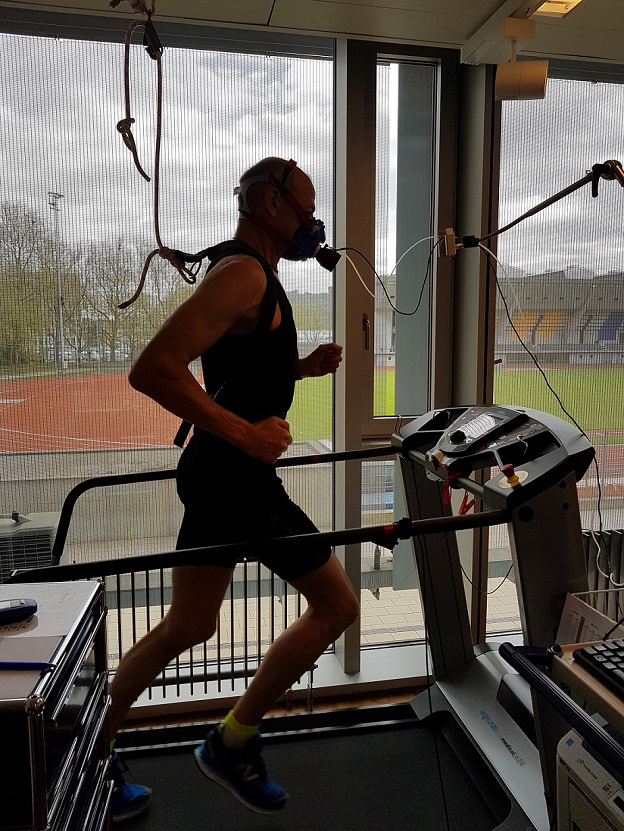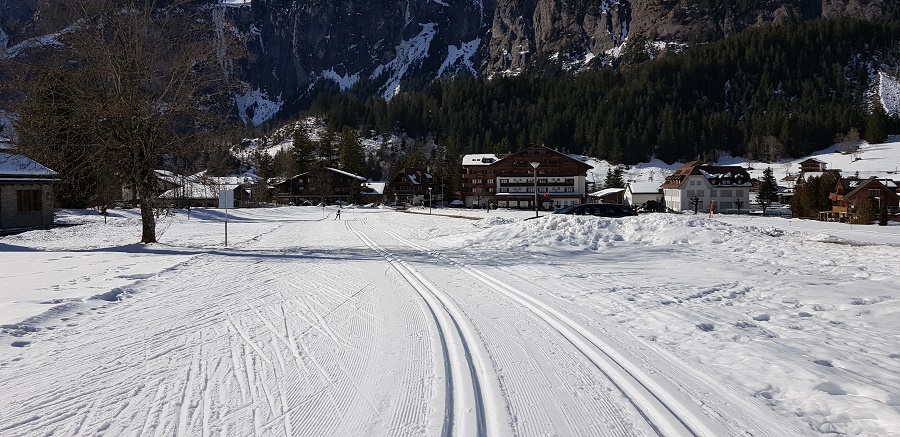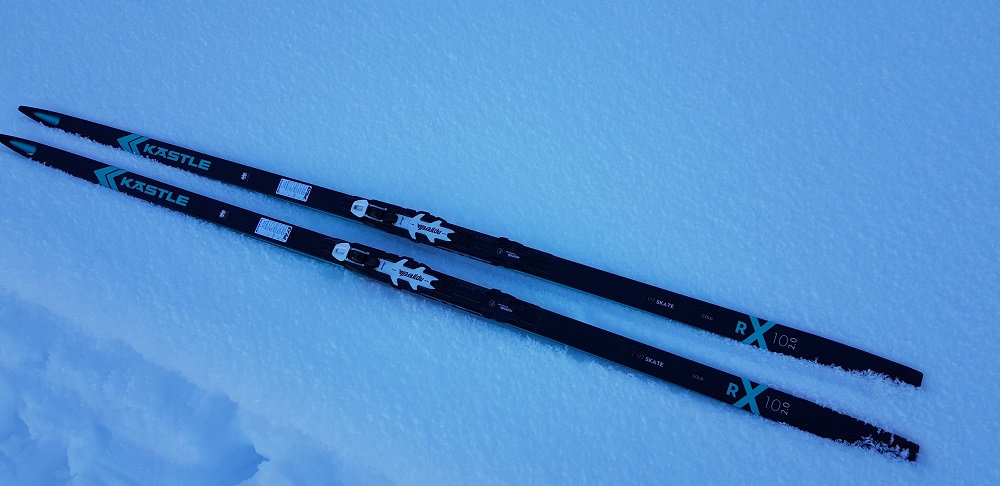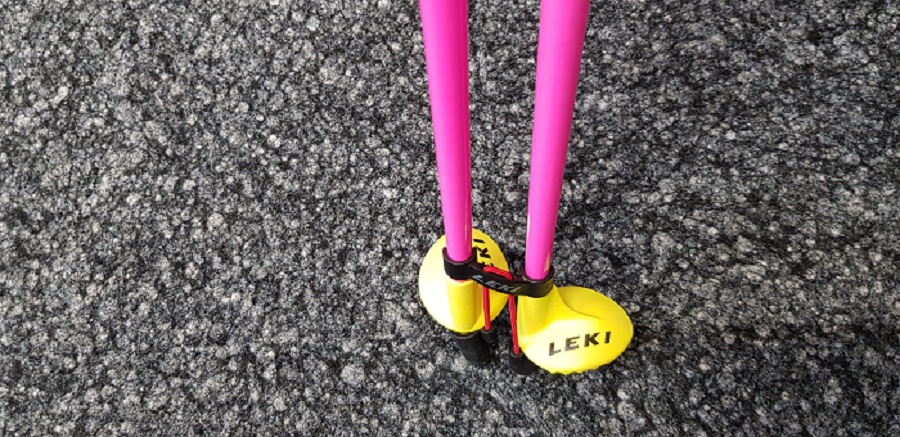- Home
- Training
How to Boost Your Nordic Skiing Fitness to The Next Level
A good Nordic skiing fitness is essential if you want to expect a respectable result in ski competitions.
If you are a Nordic skiing fitness athlete with a high VO2 max, you have a big advantage. After all, most XC skiers who won Olympic and World Championship gold medals had very high VO2 max. The men exceeded above >80 and the women above >70 mL·kg−1·min−1.
So, your performance criteria is the maximum oxygen uptake. But even if you can increase your performance criteria only from 20 to 50 percent, you can push it up with the right training.
Now you may think that World Cup skiers have it easy, they somehow always find snow during the summer.
This is only partly true! Yes, they have regular training camps on a glacier with perfect tracks. And in Europe, they can train in one of the few ski tunnels available. Or they can use even snow farming that has only emerged in recent years.
But even the top cracks do a significant part of their training during the summer without snow. That’s because you can do all alternative training without the white splendor.
How to Get in Shape
for Cross Country Skiing
Nordic skiing fitness
is like a sophisticated puzzle. The training sessions come in different forms,
intensities, and exercise modes. Before you want to start any high intensity interval training sessions, you should be familiar with the 5 heart rate training zones.
The advantage over other sports is that it offers you a large pool of training equipment. That means, you can use a variety of training options to fit over the summer.
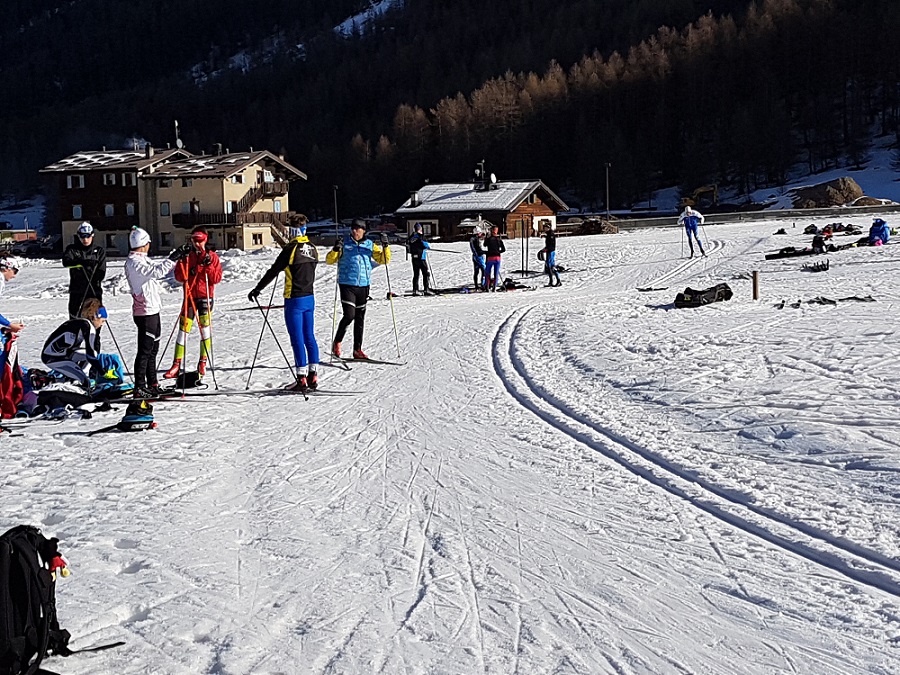 XC ski training in early November in Livigno, Italy
XC ski training in early November in Livigno, ItalyIn general, you could say that the runner runs, the rower rows, the cyclist rides his bike, and the swimmer swims.
What about you, the cross-country skier? Well in the winter, you strap on your skis. But during the summer, you change your training equipment almost every day.
As you are aware you could take a big step forward if you train more specific. But how that looks in practice, often doesn’t even know the most ambitious XC ski endurance athlete.
Just in case you are wondering, the National XC ski teams start with the high-volume low intensity training (HVLIT) or the pyramidal training model. And then in the fall and during the ski racing season change to a polarized training model.
So, let us have a look how you can boost your Nordic skiing fitness to the next level.
The most important training forms for XC skiing
When you think about training in the summer, the first thing that will come to your mind is “roller skiing”. A good alternative is also the so-called “Nordic ski walking”, which is semi-specific.
When Nordic walking, most walkers only dangle along their poles. But when ski walking, you push off explosive with every step you take. Additionally, you also drive your arm all the way back past your hip.
After each leg push off, there is a short break on the standing leg. The speed isn’t as decisive, but the quality of the movement is. Thus, Nordic ski walking comes close to the classic diagonal ski technique.
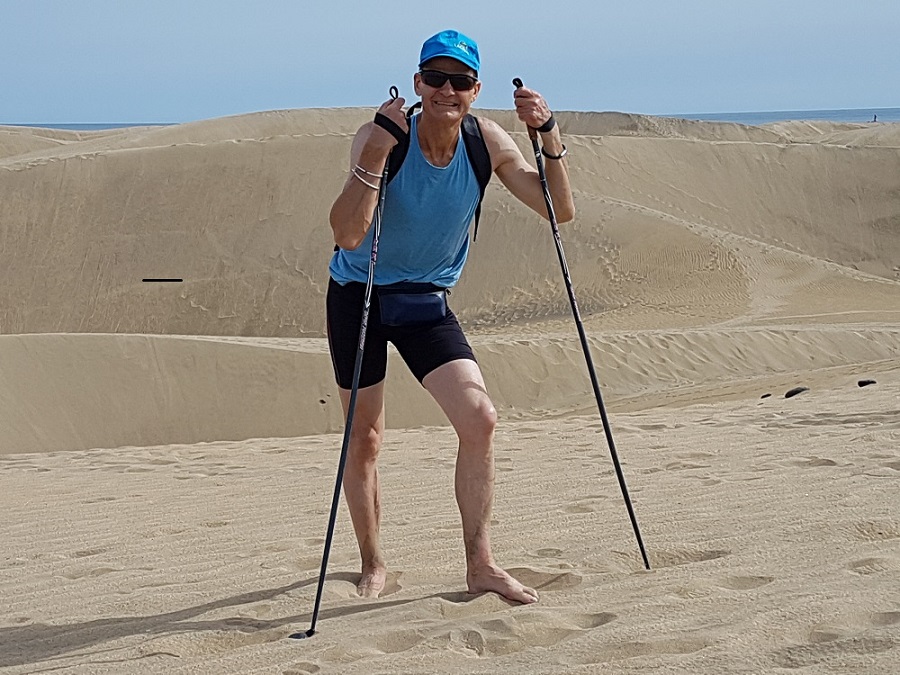 Ski walking in the sand dunes in Gran Canaria
Ski walking in the sand dunes in Gran CanariaIt is particularly used in moderate and sometimes in steep uphills. When you are in flat or downhill terrain, you carry your poles in the middle while running.
Speed-hiking up a mountain (walking up a mountain) with your ski poles is also very suitable. This is especially beneficial if you are living in the mountains.
Another way to imitate skiing is Nordic running with your poles. The top XC ski cracks use Ski bounding or Nordic running also for interval training.
Nordic running simulation targets your arm movements and improves your coordination. This is perfect training for classic style skiers.
Running only also improves your Nordic skiing fitness. But of course, it’s not as specific but builds your endurance base.
Cycling or Mountain Biking
Cycling and mountain biking belongs to the general training forms for XC skiers. The idea is to build a broad and stable base during the spring and summer.
Yet, I know of older Master competitors who train by cycling and mountain biking all year around. They can’t run anymore because of lower back or knee problems.
And the constant pounding of running also doesn't make it any better. But those athletes do a great amount of roller skiing during the summer. So, that means only by cycling or mountain biking, you can't reach your Nordic skiing fitness.
At the beginning, you start cycling in flat terrain. Later on, the intensity increases after the preparation phase 1, which ends in the month of August.
Road cycling up a mountain is excellent to build strength endurance in your legs and hips. The goal here is to chase lots of vertical meters. Besides, when cycling up a mountain, there isn’t much of recovery.
You are always braking and then starting again while biking through forests. So, it's quite different from road cycling.
I advise you to do the bulk of cycling during the spring and early summer. Then in late summer and fall you switch to do more running and roller skiing.
Roller Skiing
Roller ski training builds the most specific Nordic ski fitness and comes closest to XC skiing on snow. But even if roller skiing is the most specific summer training mode, it's not quite so easy to handle.
Particularly popular is roller skiing by committed cross country ski Masters. They train specific and a lot, which mean 2 - 4 times a week.
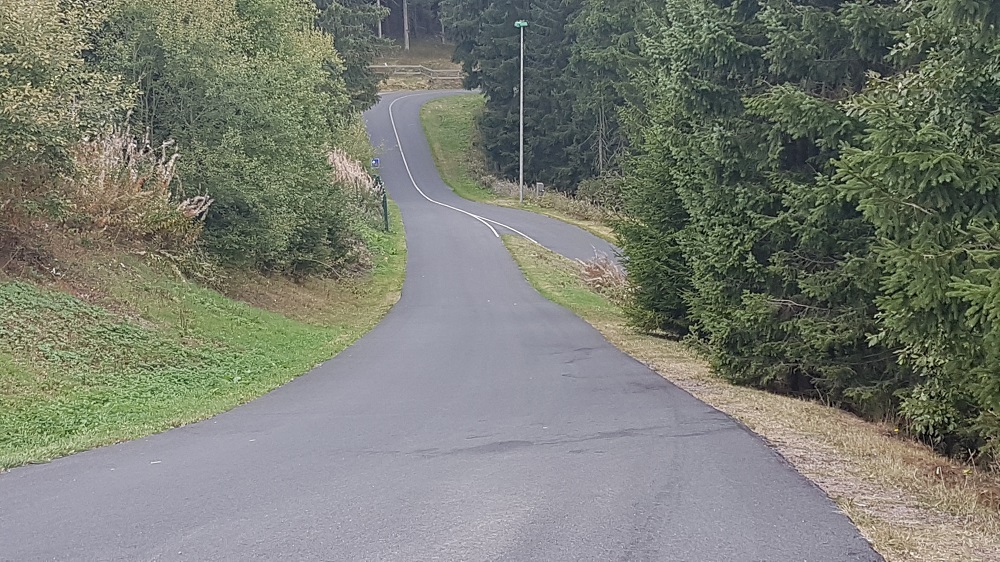 The roller ski track in Oberhof, Germany where many top XC ski athletes occasionally train
The roller ski track in Oberhof, Germany where many top XC ski athletes occasionally trainToday, there are now brakes for roller skis on the market that makes training a lot safer.
Thus, roller ski training is also the best form of training for less skilled cross country skiers. And skiing on a road in the classic technique doesn’t need any more space than a bicycle, compared to skate skiing.
It’s wise to check out roads with little traffic or even better roads that aren’t permitted for cars.
Doing regular roller ski workouts should make you feel more comfortable come winter. That's why I recommend 1-hour sessions and once a week a longer workout the right dose.
I realize that you may not have an interest to do part of the training by roller skiing during the summer.
This may be the case when you haven’t done much roller skiing before. It could also be that you are at an age and are more concerned about your safety first.
If so, continue reading, there is an alternative.
Strength Training
Cross country skiing is a very dynamic sport, which uses almost every muscle in your body. To be able to ski at a brisk pace over a longer period, you need well-developed strength endurance. Having lots of strength endurance resists muscle fatigue.
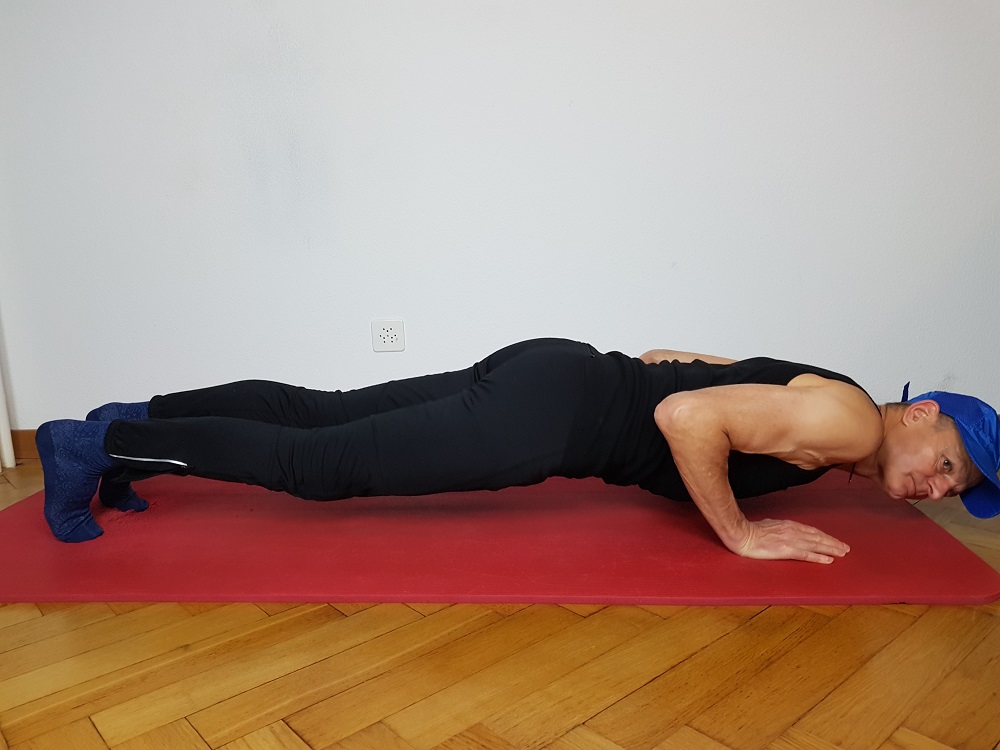 For general strength exercises, push ups are effective for your upper body
For general strength exercises, push ups are effective for your upper bodyYou improve your strength endurance ability through different strength training forms.
You can mix in your strength sessions with long endurance workouts. It distinguishes between general, semi-specific and specific training forms.So the training to acquire your Nordic skiing fitness is very diversified.
To general strength training counts training on equipment in the gym or in your home. Also stabilization exercises are a part of strength training.
In semi-specific strength training, you can use different types of pulling devices. This could be rubber bands, or different pulling devices. Those could be like the “Ercolina” pulling machine, or the “skierg“ .
You could also build yourself a rollerboard to use at home. It may be old-fashioned but it works. The use of these pulling devices are best right after an endurance workout. For ex: Add 30 min after a 1-hour run or roller ski workout.
The specific strength training contains longer double pole training sessions uphills. Or ski imitation exercises before or after a run.
Plyometrics, Balance
Training and Stability Exercises
To get the most of your Nordic skiing fitness, it’s best to include plyometrics, balance and stability exercises.
For example, at the end of a 1-hour easy run, include 15-20 minutes of plyometrics. For ex: exercises like moosehufs, one-legged jumps, frog leaps, skate bounds etc.
You can do the same with balance training. Before a strength training workout, include some simple balance exercises for 15-20 minutes.
So here you have it.
The question is how you put it all together. The trick to gain a high Nordic skiing fitness is to put the puzzle together in the right order.
As a coach, I can advise you and work out a plan with you according to your time availability.
- Home
- Training

